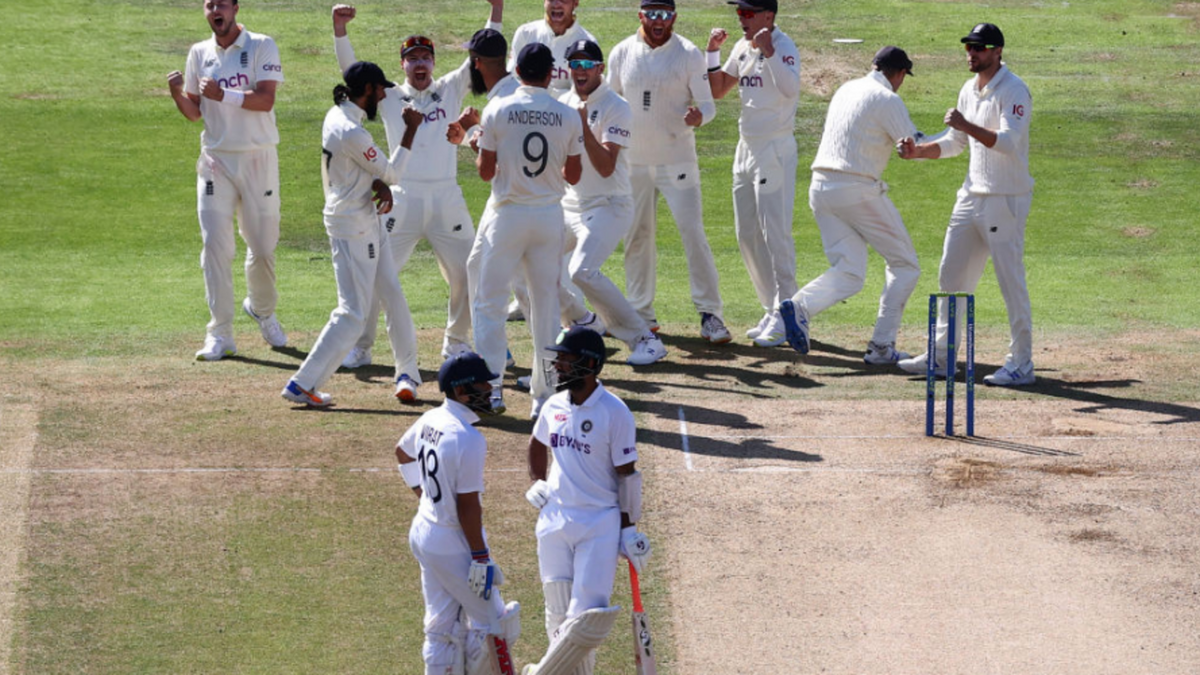
Though India lead 2-1, the series is far from over. They should be wary of loss of a focus after the wins at Lord’s and The Oval, for one hour of bad cricket could cost them the trophy, writes Divy Tripathi.
“In the last Test match, we had two good days, just one bad hour where we actually lost it completely…”
These were the words of the stand-in skipper Ajinkya Rahane when describing India’s horror show in Adelaide during the 2020/21 Border-Gavaskar Trophy. What followed was one of the most remarkable fightbacks in history of the game. And this England series has been a testament to the fact that the Indian performance down under wasn’t a one-off.
However, it would count for little if India were to fall at this crucial juncture. Though they have a series win within their grasp, all their work would come to naught if they slip up at Manchester. For all the exceptional cricket they’ve played so far, the series isn’t over yet.
England don’t have the strongest of home records of late, but they are yet to lose a series with three or more Tests since 2012. They’ve time and again shown their propensity to fight back at home, as was the case during the 2019 Ashes. In that series, Australia dominated the proceedings, barring the Ben Stokes miracle at Headingley, but seemed to lose the steam in the final Test at The Oval. The end result of 2-2 meant that Australia retained the Ashes, but they failed to become the first Australian team to win a Test series in England since 2001.
This achievement might have satisfied Tim Paine’s Australians but Virat Kohli & Co. will surely look for higher goals. This is a side which breathes ‘intent’ day in and day out as a part of their team philosophy. The same team which went for an almost impossible chase in The Oval 2018, would be sorely disappointed if they miss out on an all-important series win in England.
Having seen the English capabilities on full display and their own frailties exposed at Leeds, India should understand that they can’t take the final Test lightly. They should also understand that they can discount their collapse at Leeds at their own peril. For it is one bad hour of cricket, which can turn the game away from them.
Virat Kohli sought to explain the collapse at Leeds as, “quite bizarre. It can happen in this country, batting collapses.” And he wasn’t wrong. Since 2015 England has been home to six instances of a side being bowled out for under 100.
What is also true though is that the Indian side under him have seen too many of these bad hours which have returned to haunt them later in the game. Since 2015, batting collapses have played an important role in wresting control away from the India team. In the 15 Test losses during that period, there have been seven instances where India lost their last seven wickets at an average of eight or less runs per wicket.
While, statistics alone tell only half the story, they nevertheless make for an interesting narrative. For instance, between 2009 and 2014, India lost 20 Tests, however, there were only three instances of a similar collapse in these games. Kohli’s India rarely gets outplayed throughout a contest, but can be guilty of putting themselves in positions they can’t fight back from.
These bad hours of cricket have included several situations where the middle and lower-order have failed to capitalize on the starts provided by the top-order. In the 2020/21 Adelaide Test, remembered more for India’s infamous capitulation in the second innings, they were 188-3 before being bowled out for 244 in the first innings.
If we were to be slightly liberal with the above methodology, India’s collapse in first innings during the WTC final, with seven wickets lost for 68 runs, ensured that New Zealand could find a way back in the final. In both instances, wickets fell right before or around the time new ball was taken.
There is a prolonged discussion on India’s lower-order being unable to contribute well enough in recent times. However, the situation worsens when there is little help from middle-order.
Two of the above seven instances happened in Leeds recently. There is without a doubt that the Indian team have looked at addressing their middle and lower-order conundrums of late. Rishabh Pant got a second innings promotion in Sydney when India were in a perilous position, while Ravindra Jadeja was sent in at No.5 to deal with the English bowling at The Oval. The addition of Shardul Thakur also added as a boost to the Indian batting lineup.
India would need the best combination and strategy to ensure that they return as a side which is a winner of trophies away from home, rather than simply being a side with a tally of away wins.








